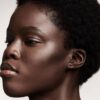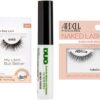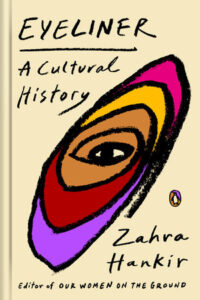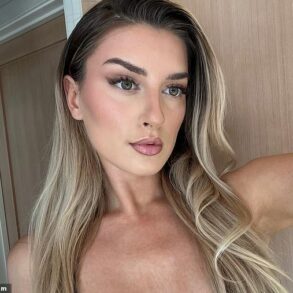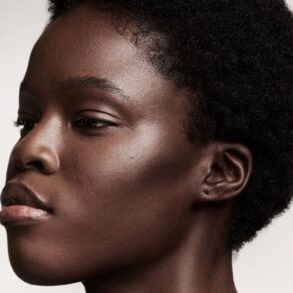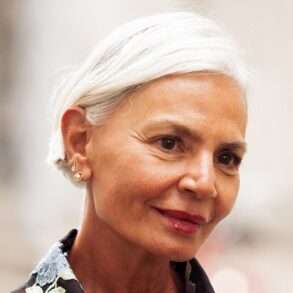Despite its ubiquity, there’s more to eyeliner than meets the eye. This seldom-examined object frames the eyes of women on the New York City subway and nomads in the savannahs of Chad. Instagram influencers experiment with graphic liner designs, and supermodels sport wings on Paris runways. Per religious tradition, living goddesses in Nepal decorate their eyes with the cosmetic, channeling tales both past and present.
When they can’t access retail liner, some women prisoners in the US make their own with pencil graphite and Vaseline. Fashion-conscious beatniks paired eyeliner with berets, and Russian dancers of Diaghilev’s Ballets Russes donned flicks of it while onstage. Even Mesopotamians may have used kohl, applying it with a stick shaped like a spatula. While they didn’t use kohl as prolifically as the ancient Egyptians, ancient Greek women darkened their eyes with a mixture of soot, antimony, and burnt cork.
The Prophet Muhammad was said to have worn a form of eyeliner, too, and spoke of its healing properties. There are traces of the cosmetic in the Old Testament, which mentions figures, including Jezebel, with “painted eyes”; two were “harlots,” though the use of eye paint was not strictly considered objectionable per the scriptures. A vast and by no means comprehensive array of individuals, indeed, such is eyeliner’s staying power.
After the onset of the COVID-19 pandemic, eyeliner sales soared—and lipstick sales plummeted—due to the widespread use of face masks. In 2021, the eye makeup industry’s value rose to $15.6 billion; it is expected to expand further to $21.4 billion by 2027. The growth trajectory is staggering. It comes as no surprise, however, that eyeliner and eye pencils constitute the largest market segment, edging out mascara and eyeshadow by 5 percent.
Like ink itself, eyeliner helps us deliver messages to the world.
Throughout time and across space, the primary purpose of applying eyeliner has remained the same: to make the eyes appear larger or more attractive. Depending on the day, eyeliner wearers may be sultry or demure, rebellious or clean-cut, low-key or loud. Like ink itself, eyeliner helps us deliver messages to the world: we are confident, we express ourselves, we are our own creations. There’s an eyeliner style and a story for virtually every look. Some are even protecting themselves from evil spirits or honoring a god, while others may be treating their eyes for an infection or blocking the sun.
The art of eyeliner application can be painstakingly precise: experts employ the care and consideration a painter or a calligrapher might use on a blank canvas. The rules are many, though malleable, and the technique can take years to perfect. The applicator must move steadily, to ensure the pigment glides seamlessly onto the eyelid or waterline. Apply too thick a line to the lid, and you risk shrinking the eye; apply lines that bleed, and you may give your eyes an undesirable raccoon effect.
Different eye shapes can suit different styles—a black line on the lower waterline can make small eyes look smaller, whereas a single line along the upper lid may make them look bigger. Hinging on the angle of the upturn, wings can widen the eye—or, according to one TikToker, even reveal whether the wearer is a millennial or Gen Z. A small twitch of the hand may necessitate starting from scratch, a time thief that spares almost no one.
Applicators come in many forms, from fingers and bones to brushes and plastic rods. Some people use their pinkies to finetune their imperfect lines, while others use stencils, wipes, or cotton swabs. Color and consistency are important, too. Black eyeliner can be aging, while brown, green, or blue can be more flattering. (Princess Diana famously wore blue eyeliner, likely to echo the blue in her eyes.) Liquid, gel, and cream eyeliners are best used on lids, while pencils and powders work well on waterlines. And then there’s the shape and length of the lines; the choices are endless, as Instagrammers and TikTokers have made clear. Your eyeliner can even be “sharp enough to kill a man,” declares one popular meme—and cat-eye devotee Taylor Swift.
The effort pays off. Eyeliner, of course, can make a person appear significantly more attractive, and attractiveness, or “pretty privilege,” is meaningfully associated with a disturbingly wide range of positive social and economic outcomes (though often a woman would have to be “conventionally” attractive to benefit from this privilege). Women, especially women of color, are held to high and specific standards when it comes to their appearance at work.
In the office, women who wear the right kind of makeup— not too heavy, not too light—are seen as more competent and effective leaders; a pronounced wing may be looked at less favorably than tightlining. When worn well, eyeliner can give the illusion of doe eyes, implying youth. And those with “baby faces” are thought to fare better in life as they’re perceived to be more honest, trustworthy, or charismatic than others.
Conversely, some young people wear eyeliner to appear older or more mature. Twelve-year-olds Alice Craig and Cristina Wilson, grade-school classmates who now attend different Manhattan middle schools, gather in friends’ bedrooms on weekends to trade eyeliner techniques gleaned from YouTube tutorials. Among their group, the girls explained, eyeliner is the cosmetic of choice. “It’s not about looking ‘cute,’” Wilson says. “Eyeliner makes you look cool and bold. It makes you look older, too. It’s not like anyone will think you’re fifteen. But maybe they’ll take you more seriously.”
“A lot of girls we know mostly use makeup to cover up things they think are flaws, or they’re doing something subtle to look prettier but natural,” says Craig. “I think if that makes you feel more confident, go for it. But my friends and I don’t find that way of using makeup very interesting. Eyeliner is different. It’s basically the opposite of subtle or ‘naturally pretty.’ Eyeliner shows your personality.”
This is eyeliner’s sheer power, unmatched by those other items in your makeup bag.
*
Eyeliner can be found in practically every corner of the cultural landscape. It is frequently used as a tool to signify transformation, often flicking at themes of adulthood, theatricality, allure, sensuality, power, or defiance. On Western screens, high-intensity eyeliner has also been used to signify madness or transgression. Femme fatales such as Akasha, played by the late Aaliyah in the 2002 film Queen of the Damned, and Julie Marsden, played by Bette Davis in the 1938 film Jezebel, were made up in eyeliner (Graham Greene memorably described Davis as having “popping, neurotic eyes, a kind of corrupt and phosphorescent prettiness”). Twisted male protagonists like the late Heath Ledger as the Joker in The Dark Knight and Robert Pattinson in The Batman wore smudged lines.
In the Netflix series Orange Is the New Black, several of the rebellious female inmates at a New York prison creatively and consistently trace their eyes with pigment, my favorite look being the long and thin flicks worn by the gutsy Maritza Ramos, played by Diane Guerrero. In Game of Thrones, the nomadic group known as the Dothraki wear eyeliner prolifically, particularly its male warriors on horseback.
The troubled chess player portrayed by Anya Taylor-Joy in The Queen’s Gambit draws lines that grow more dramatic as she becomes progressively more unhinged; in an alcohol-induced haze, she paints floating lines a centimeter below her natural lower lashes, producing an uncanny, doll-like effect. Eyeliner, incidentally, isn’t always used on the eyes. John Waters, the American filmmaker and director, creates his trademark pencil mustache with Maybelline’s Expert Wear Velvet Black eyeliner.
Eyeliner has also served practical purposes in the arts. During the 1920s, with the introduction of “movie palaces,” films were broadcast in black and white, and directors required that cast members line their eyes to ensure they popped against a monochrome backdrop. In theater and opera historically performed against candles or lamplights, eyeliner was applied liberally to performers’ faces to help the audience see their expressions more clearly.
Some celebrities and artists have had especially intimate relationships to their liner, so much so that it became a trademark that they would be unrecognizable without. Consider, for a moment, Amy Winehouse without her graphic wings, or a barefaced Trixie Mattel.
*
Around the world, eyeliner is recognized as a transformative tool. But its historical beginnings are deeply rooted in Eastern traditions, notably in ancient Egypt, where the earliest known usage dates back to at least 3100 BCE. There, eyeliner was not merely turned to for beautification; it also had medicinal and spiritual significance.
In Africa’s ancient Land of Punt, galena was likely used as a source for kohl, as evidenced by trade between the kingdom and ancient Egyptians. People across the continent, from Berbers in Morocco and Oromos in Ethiopia to nomads in Chad, also use kohl to repel the sun and to beautify or medicate their eyes. However one refers to eyeliner in the Global South—kajal, kohl, surma, or sormeh—the cosmetic has been highly influential, and can convey messages about power, religiosity, and a commitment to moral codes.
In the Arab world and spanning swaths of Asia and Africa, some mothers still apply kohl to their newborns’ eyes to ward off the evil eye, the superstition that a jealous glance or gaze can cause harm. Across South Asia and Africa, many Muslims don’t look at kohl, surma, or kajal as makeup, but rather as an element of their faithfulness and an integral part of preparing for religious holidays including Eid and Ramadan.
Communities of color today also use eyeliner to express themselves and assert their identities in the face of marginalization and white supremacy. Ziwe Fumudoh, an American talk show host who went viral for pressing her interviewees on Black culture and politics, often boasts a signature eyeliner look. “Most hosts are like, ‘What’s your next project? How can we promote it?’ as opposed to ‘How many Black friends do you have? What do you like about Black people qualitatively?’” she told Allure in September 2020. “I’m asking those questions with my intense eyeliner and pigment on my face. I’m trying to contextualize these products that I have and bring them into conversations about race and class and gender…. Nothing exists in a vacuum. I don’t exist in a vacuum, the makeup I wear doesn’t exist in a vacuum.”
New York–based writer Elaine Louie, who’s been wearing smudged kohl ever since she was a teenager living in San Francisco, says she’s so committed to her look, she sleeps in her lines. “Back in the day, I ruined oodles of white sheets,” she says as she shares her kohl memories with me. “Now I have charcoal-gray sheets,” which help obscure residue, she adds, joking that she sometimes even reapplies it in the middle of the night.
The liner itself is, ultimately, an accessory to a far bigger story, one that encompasses human ambition and creativity.
Jokes aside, Louie, like so many of the figures in this book, and like so many people around the world, myself included, turned to eyeliner as she came of age to help enlarge her eyes, find her personal style, and boost her confidence. “It wasn’t just about how you looked,” the eighty-year-old writer, who is of Chinese heritage, says. “It was about how you felt. It was about this aura you have. That maybe you were just a little bit exotic.” Taking it a step further, Rosana Cipriano, a resident of Rio de Janeiro, says, “Eyeliner can even bring my soul out of my eyes.”
*
This book embarks on a journey through time and across continents to tell just a few of these stories about our enduring obsession with a remarkable substance. Beginning, fittingly, in the East, we’ll delve into ancient Egypt to understand the original beauty icon, Queen Nefertiti, and her lasting influence on eyeliner use. Challenging the notion that beauty is an inherently female preoccupation, we’ll turn to the Wodaabe people in the savanna region of Chad. To demonstrate how sormeh has been used as a critical instrument for self-expression and political resistance, we’ll reflect on the eruption of protests in the wake of the killing of Mahsa Amini in Iran.
Next, we’ll travel to Petra, Jordan, to illustrate how kohl helps communities maintain and celebrate centuries-old traditions. We’ll then get to know Mexican American cholas in California and see how eyeliner can assert cultural pride in the face of racial discrimination and marginalization. Investigating kajal’s relationship with the divine and the ethereal, we’ll wander over to India to visit Kerala’s storytellers. We’ll later explore the social implications of the eyes and eye contact in Japan, and meet a millennial geisha in Kyoto.
Back in the West, we’ll attend drag shows in New York, exploring the connection between this transformative cosmetic and gender. With a focus on Amy Winehouse, we’ll observe the phenomenon of the Western pop star, and witness how the substance can play a significant role in one’s physical and psychological development and protection—and even in one’s mental health. Finally, we’ll meet a few of the influencers both shaping and responding to ever-evolving beauty ideals in the age of social media.
*
Eurocentric beauty norms have dominated the global beauty discourse in decades past, alternately by suppressing and mocking or fetishizing and cherry-picking unique cultural features and practices found in and founded by so-called exotic societies and groups. This book is a celebration of the innovative contributions of people of color to the beauty industry and the vibrant array of beauty practices around the world.
I ask you, dear reader, to eschew the Western gaze, and to sensitively and thoughtfully expand your understanding of beauty, as well as of the relationship between beauty and power. Though these chapters attest to the rich cultural history of eyeliner, the liner itself is, ultimately, an accessory to a far bigger story, one that encompasses human ambition and creativity, innovation and versatility . To wear eyeliner and to learn about its origins is to bring not only ourselves, but also some of the world’s most fascinating cultures, into focus.
__________________________________
From Eyeliner: A Cultural History by Zahra Hankir, published by Penguin Books, an imprint of Penguin Publishing Group, a division of Penguin Random House, LLC. Copyright © 2023 by Zahra Hankir.
This post was originally published on this site be sure to check out more of their content.


